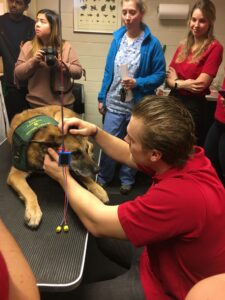Every student or audiologist who has worked in a clinical setting has least one story of an appointment that just didn’t quite go as planned, or a patient whose cooperation tested the limits of your own patience. Re-instruction, effective counseling, or the ever-reliable Stenger are a handful of ways clinicians can put a “leash” on appointments outside of our control. Imagine your waiting room is filled with twelve, 7-week old patients, all of whom are excited, noisy, and making a mess of your office space. While they may look cute and cuddly, no level of counseling or re-instruction will help in this situation. In fact, you may need a literal leash at the ready. No, this isn’t a busy NICU on newborn hearing screening day; it’s a typical afternoon at the University of Cincinnati’s Fetch Lab, where twelve Dalmatian puppies wriggled and yelped their way into your arms, excitedly awaiting the results of their hearing test.
The University of Cincinnati’s Facility for the Education and Testing of Canine Hearing and Laboratory of Animal Bioacoustics (Fetch Lab) is one of the only university research labs in the country that provides education on animal audiology*. Through a combination of specialized coursework and clinical hours in the lab, students can obtain their Certificate in Animal Audiology. But how does one perform a hearing test on a puppy or dog without asking them to raise their paw in response to the softest beeps? The same way clinicians obtain diagnostic responses from infants who aren’t quite ready for a behavioral hearing test; only with a little more poking involved. A numbing ointment on the surface of the animal’s forehead and outside the canals of both ears, needle electrodes are inserted just below the skin’s surface into the designated grounding, reference, and testing sites. A click stimulus is elicited into the animal’s canal, and a brainstem auditory evoked response (BAER) waveform is analyzed to determine a pass or fail hearing screening result.
There are approximately 80 breeds of dogs who are susceptible to genetically related deafness and hearing loss. Those numbers increase even further when you consider the K9 officer, military, and other service dogs who are exposed to the same damaging noise levels that humans can experience in their own work environments. Many working dogs rely on their ability to hear commands from their owners and handlers to effectively perform their role. Evaluating hearing is not only critical to the overall health of these hardworking animals, but also helps ensure that they are in peak condition to serve the community as members of SWAT, search and rescue, narcotics, and other teams. Additionally, efforts to eliminate genetically inherited medical disorders that stem from interbreeding has called for breeders to maintain a healthy genetic bloodline in their animals. Hearing tests provide important information to ensure that hearing loss is not bred into future generations.
While Fetch Lab dedicates a significant amount of time to the assessment of hearing in dogs, their involvement in animal audiology does not stop with those with four legs. The lab is also a research-based organization dedicated to hearing conservation and increasing knowledge of animal bioacoustics. The Executive Director, Dr. Pete Scheifele, has worked with a variety of exotic animals throughout his life. Most recently, his work has brought him to the Indianapolis Zoo where his team has been hard at work performing ABRs and mismatched negativity on the facility’s dolphins. From raptors (fancy name for Bird of Prey – no Jurassic involvement yet), to rhinos, horses, and even beluga whales, the Fetch Lab has made a name for itself as a worldwide leader in animal audiology and bioacoustics.
Working in the lab has its fair share of perks, including the cutest patients on the planet and unlimited licks, the research and work from the lab has an impressive impact on the areas of audiology and biology. This exciting territory opens the doors for new fields of practice and discoveries that can lead the way for innovation in hearing conservation and animal communication.


*The University of Cincinnati stands as the headquarters for Fetch Lab, however, there are currently additional Fetch Labs at the University of Northern Colorado and University of Akron.
Bethany Wysocki is a fourth-year graduate student from the University of Cincinnati, currently completing her externship at St. Louis Children’s Hospital. She served as the Fetch Lab manager at UC for 2 years and has obtained her Certificate in Animal Audiology. Her professional interests, in addition to working with four-legged patients, include providing rehabilitative services for pediatric patients with cochlear implants and hearing aids.
Related Posts
Pathways to Audiology: Sarah Jones, AuD
Welcome to the national Student Academy of Audiology (SAA) Pathways to Audiology Interview Series! While many audiologists come from a Communication Science Disorders (CSD) background, others have taken different pathways to the field. In this series, the national SAA will interview both audiologists and AuD students who have or are taking non-traditional routes into the profession…
Pathways to Audiology: Alexander Morris, AuD
Welcome to the national Student Academy of Audiology (SAA) Pathways to Audiology Interview Series! While many audiologists come from a Communication Science Disorders (CSD) background, others have taken different pathways to the field. In this series, the national SAA will interview both audiologists and AuD students who have or are taking non-traditional routes into the profession…
Pathways to Audiology: Batoul Berri, AuD
Welcome to the national Student Academy of Audiology (SAA) Pathways to Audiology Interview Series! While many audiologists come from a Communication Science Disorders (CSD) background, others have taken different pathways to the field. In this series, the national SAA will interview both audiologists and AuD students who have or are taking non-traditional routes into the profession…


